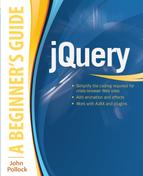Introduction
Welcome to jQuery: A Beginner’s Guide! Several years ago, I noticed that there was a new popular term emerging on the Web: jQuery. Of course, I got curious and decided to go find out what this meant.
I quickly found out that this was a JavaScript library, but not just any library. This one provided the means to easily select elements and create dynamic effects with less code being required from the developer. Not only that, it also turned many of the cross-browser worries often encountered in JavaScript code into things that developers didn’t need to pull their hair out about any more when using the library: It provided support even for older versions of Internet Explorer!
After seeing this, I felt this would be a helpful library to use when I needed to complete a JavaScript program that required support for older browsers such as Internet Explorer 6. Rather than worrying about the additional coding that would be needed to make the program compatible, the program could simply be written while jQuery made it consistent with each browser in the background. This made jQuery the perfect choice as my first library to learn in detail.
Why This Book?
Learning a new language or API (application programming interface) can be difficult even when great documentation is available. Many times, it is helpful to have a gentle introduction to the topic, especially if one is unfamiliar with the terms and practices that are used when talking about it. This book is designed to guide beginners to jQuery/JavaScript so that they can get started easily and learn all of the terms that will be needed to understand the topic fully.
Web designers, Web developers, or JavaScript programmers who want to learn to use jQuery from the beginning will find this a good place to start. With a gentle introduction and explanation of the terms often used, this guide provides a means for beginners to start using the jQuery library.
What This Book Covers
This book covers the basics of adding the jQuery library, element selection, event handling, animation, form validation, AJAX, use and creation of plugins, and more, and includes special features to help you along the way as you learn. These include
![]() Key Skills & Concepts Each chapter begins with a set of key skills and concepts that outline the topics you will want to understand by the end of the chapter.
Key Skills & Concepts Each chapter begins with a set of key skills and concepts that outline the topics you will want to understand by the end of the chapter.
![]() Code Code listings display the source code used with each example.
Code Code listings display the source code used with each example.
![]() Callouts Callouts point to specific lines or sections of code and provide helpful hints or notes about the code.
Callouts Callouts point to specific lines or sections of code and provide helpful hints or notes about the code.
![]() Notes, Tips, and Cautions Notes, Tips, and Cautions call your attention to noteworthy statements that you will find helpful as you move through the chapters.
Notes, Tips, and Cautions Notes, Tips, and Cautions call your attention to noteworthy statements that you will find helpful as you move through the chapters.
![]() Ask the Expert The Ask the Expert sections let you see what types of questions are commonly asked about certain topics, with responses from the author.
Ask the Expert The Ask the Expert sections let you see what types of questions are commonly asked about certain topics, with responses from the author.
![]() Try This These sections get you to practice what you have learned using a hands-on approach. Each Try This section will have you code a script through step-by-step directions on what you need to do to in order to accomplish the goal. You can find solutions to each project on the McGraw-Hill Professional Web site at www.mhprofessional.com/computingdownload.
Try This These sections get you to practice what you have learned using a hands-on approach. Each Try This section will have you code a script through step-by-step directions on what you need to do to in order to accomplish the goal. You can find solutions to each project on the McGraw-Hill Professional Web site at www.mhprofessional.com/computingdownload.
![]() Self Test Each chapter ends with a Self Test, which is a series of 15 questions to see if you have mastered the topics covered in the chapter. The answers to each Self Test can be found in the appendix.
Self Test Each chapter ends with a Self Test, which is a series of 15 questions to see if you have mastered the topics covered in the chapter. The answers to each Self Test can be found in the appendix.
Chapters 1 through 4 cover the very basics of jQuery, from including the library in an HTML document (Chapter 1) to element selection (Chapter 2), event handling (Chapter 3), and CSS style manipulation (Chapter 4).
Chapters 5 through 8 cover further basic principles, building on what you learned in Chapters 1 through 4. This begins with JavaScript and the DOM (Chapter 5), and continues with animation/effects (Chapter 6), the Event object (Chapter 7), and form validation (Chapter 8).
Chapters 9 through 12 cover intermediate concepts, such as AJAX (Chapter 9) and plugins (Chapters 10 and 11), and touches on more advanced techniques such as debugging and unit testing (Chapter 12).
At the end of this book, you should be able to use all the basics of the jQuery library and be ready to read more advanced material on the subject if you choose to pursue it further.
If you have any questions while working through this book, you can contact me via one of the following methods:
![]() E-mail me from my Web site: www.scripttheweb.com/about/contact/
E-mail me from my Web site: www.scripttheweb.com/about/contact/
![]() Contact on Twitter: @ScripttheWeb
Contact on Twitter: @ScripttheWeb
Now, let’s begin learning jQuery!
